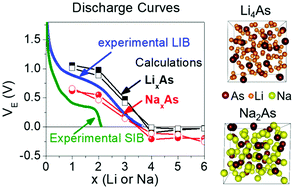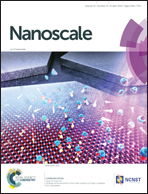Arsenic for high-capacity lithium- and sodium-ion batteries†
Abstract
We report arsenic (As) as a promising alternative to graphite anode materials in lithium- and sodium-ion batteries (LIBs and SIBs). The electrochemical properties of the As/carbon nanocomposite for both LIBs and SIBs were investigated using experimental and theoretical approaches. The LIBs showed excellent cycling performance, with a reversible capacity of 1306 mA h g−1 (after 100 cycles), which is much higher than that of Li3As (1072 mA h g−1). In the corresponding SIBs, the measured reversible capacity was 750 mA h g−1 (after 200 cycles), which is lower than that of Na3As. Extensive first-principles calculations were performed employing a structure prediction method for crystalline LixAs and NaxAs (x = 1–6) phases, as well as ab initio molecular dynamics simulations for their amorphous phases. In good agreement with the experimental LIB data, our calculations successfully predict the discharge capacity versus voltage curves, showing that the capacity of the amorphous phase reaches up to that of Li4As. In contrast, the SIB exhibited difficulty in reaching the predicted capacity (x = 3.5), probably due to significant volume expansion. Comparison of the theoretical discharge curves with the experimental data provides valuable information for the development of high-performance LIBs and SIBs.



 Please wait while we load your content...
Please wait while we load your content...